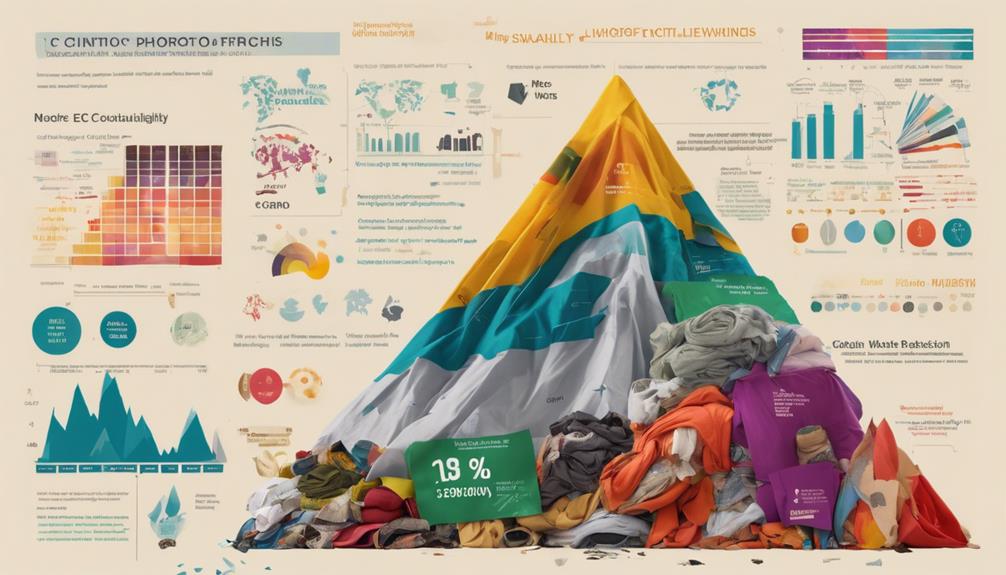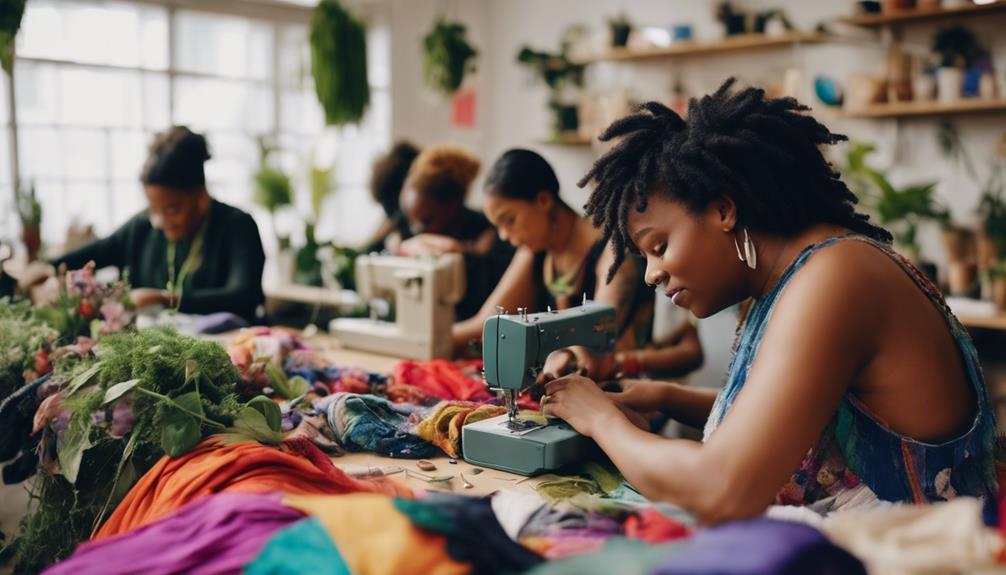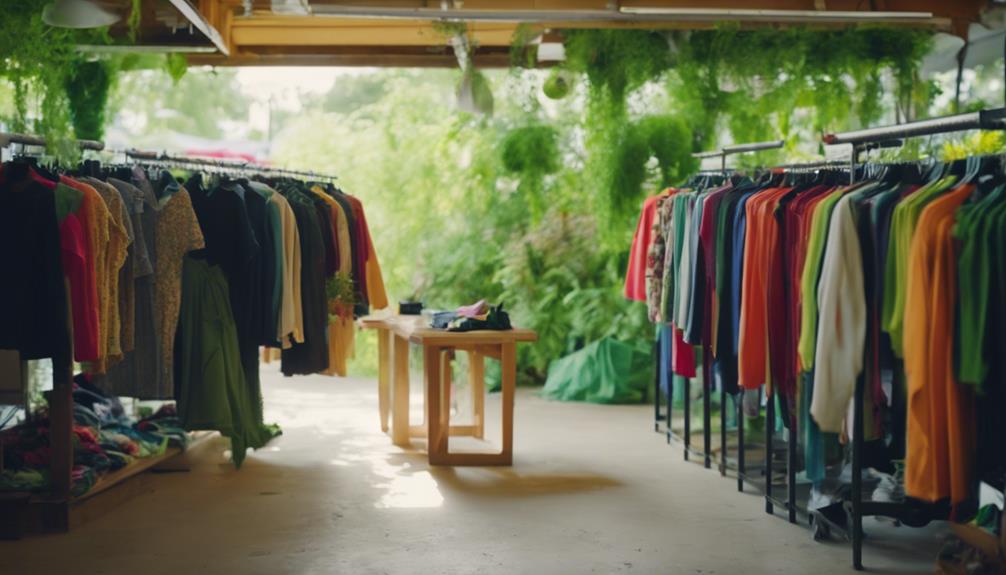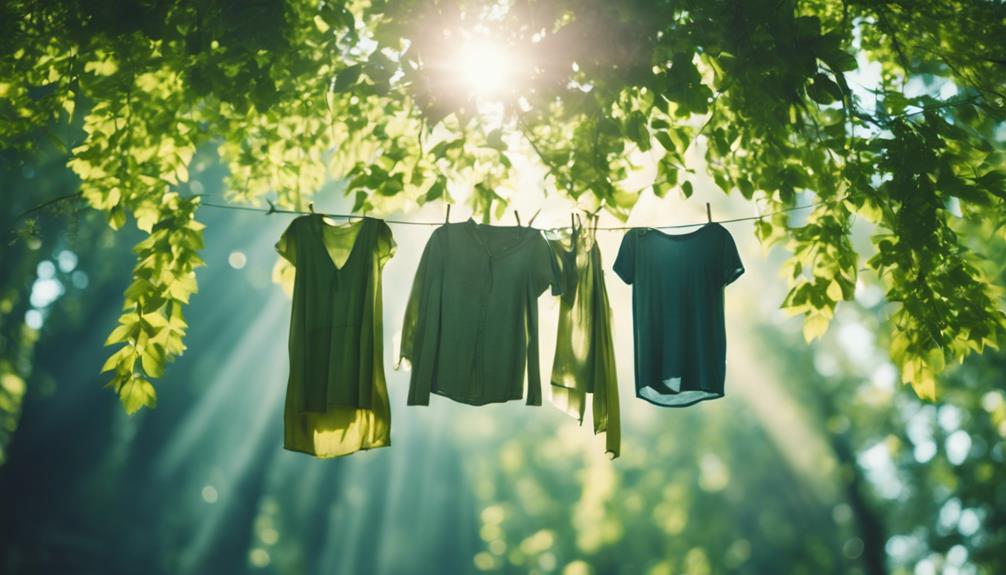Sustainable fashion plays a crucial role in reducing environmental harm caused by fast fashion. It promotes extending the lifespan of clothing, which can cut greenhouse gas emissions by up to 30%. By prioritizing recycled materials and natural fibers, you are contributing to lower water usage and reduced textile waste. Practices like upcycling and clothing rental also aid in minimizing your carbon footprint. Engaging in community initiatives such as clothing swaps promotes responsible consumption. Exploring these practices can truly revolutionize the fashion industry for the better, revealing new possibilities that were previously unseen.
Key Takeaways
- Sustainable fashion can reduce greenhouse gas emissions, addressing the 8% contribution from fast fashion to global emissions.
- Extending clothing lifespan by nine months can decrease environmental impact by up to 30% and minimize waste.
- Utilizing natural and recycled fibers can prevent 20% of global wastewater produced by the fashion industry.
- Renting clothing and participating in clothing swaps promote responsible consumption and reduce reliance on new production.
The Impact of Fast Fashion
Fast fashion's rapid production and consumption cycle greatly harms the environment, contributing to 8% of global greenhouse gas emissions. You mightn't realize it, but each time you buy a trendy outfit, you're supporting an industry that prioritizes speed over sustainability.
The fast fashion industry encourages a disposable culture, where clothing is worn just a handful of times before being discarded. Shockingly, 60% of clothing items are tossed within a year, often ending up in landfills or incinerators, which exacerbates textile waste and pollution.
As you shop, consider that clothing utilization has plummeted by 36% over the past 15 years. This trend reflects an alarming shift toward valuing new styles over durability and longevity. Additionally, less than 1% of clothing materials are recycled, leading to an annual cost of $100 billion in wasted resources. This not only squanders valuable materials but also hampers any real progress toward sustainability.
If you want to make a difference, think critically about your choices and embrace slower, more sustainable fashion options. Your decisions can help reduce the devastating impact of the fast fashion industry on our planet.
Statistics on Fashion Waste

Fashion waste is skyrocketing, with projections estimating it will reach a staggering 148 million tons by 2030 if we don't change our consumption habits.
Right now, about 60% of clothing items are discarded within a year, either ending up in landfills or incinerators. This alarming statistic underscores the urgent need for sustainability in fashion.
Over the past 15 years, clothing utilization has dropped by 36%, reflecting a growing trend towards disposable fashion. You might be surprised to learn that less than 1% of clothing materials are recycled.
This lack of recycling not only contributes to the mounting fashion waste but also leads to an annual economic loss of $100 billion, while further harming our environment.
With the apparel and footwear industries responsible for 8% of global greenhouse gas emissions, their impact on our planet can't be overlooked.
If we continue on this path, the consequences will be dire. It's essential for you to reconsider your fashion choices, as every garment you buy can either contribute to this waste crisis or support a more sustainable future.
Benefits of Sustainable Practices

Adopting sustainable practices in the fashion industry not only helps combat the alarming waste crisis but also offers numerous environmental benefits that can positively impact our planet.
By choosing sustainable products, you contribute to reducing greenhouse gas emissions from apparel and footwear, which currently account for 8% of global emissions. When you extend the lifespan of your clothing by just nine months, you can decrease the environmental impact by up to 30%.
Sustainable practices prioritize natural and recycled fibers, effectively addressing the alarming 20% of global wastewater produced by the fashion industry and tackling microplastics polluting our oceans. When you emphasize recycling and upcycling, you help uncover the vast potential for waste reduction, as currently, less than 1% of clothing materials are recycled.
Transitioning toward a circular economy in fashion allows materials to be reused and repurposed, greatly curtailing the anticipated rise of fashion waste to 148 million tons by 2030.
Innovations in Eco-Friendly Fashion

Innovations in eco-friendly fashion are transforming the industry by introducing materials and technologies that reduce waste and environmental impact.
You might be surprised to learn that brands are now creating polyester fleece from recycled plastic bottles, considerably cutting down on landfill waste. Sustainable materials like organic cotton and Tencel are gaining popularity, as they use less water and fewer pesticides during production.
Moreover, advancements in technology, such as 3D printing and digital textile printing, enable on-demand production, which helps tackle overproduction issues. This not only conserves resources but also minimizes waste. Additionally, many brands are exploring biodegradable materials and natural dyes, which have a lower environmental footprint compared to traditional synthetic options.
You'll also notice that some companies are integrating traditional techniques, like sashiko stitching, to repair garments. This practice encourages a culture of upcycling, extending the life of your clothes and reducing waste.
As you can see, innovations in eco-friendly fashion are paving the way for a more sustainable future, making it easier for you to make environmentally conscious choices in your wardrobe.
Community Engagement and Solutions

You can make a real difference in sustainable fashion by participating in clothing swaps and local events that promote awareness around fashion waste.
By building community networks, you not only share clothes but also strengthen your ties with local artisans and encourage ethical consumption.
Together, these actions can lead to a more sustainable future for fashion and the environment.
Clothing Swaps and Events
Clothing swaps and events not only promote sustainable fashion choices but also create vibrant community spaces where individuals can connect and share their passion for reducing waste. By participating in these events, you can exchange garments with others, helping to minimize the need for new purchases. This greatly cuts down on the amount of waste generated, as about 60% of clothing items end up in landfills within a year of purchase.
When you engage in clothing swaps, you're also shifting your mindset towards ethical fashion. Instead of relying on fast fashion clothing brands that prioritize profit over sustainability, you can embrace reusing and sharing. This change in consumer behavior not only benefits the environment but strengthens social ties within your community.
The fun, interactive nature of these events attracts a diverse crowd, sparking discussions about sustainability and responsible consumerism. By attending clothing swaps, you contribute to a collective awareness of fashion waste issues while enjoying the thrill of finding new treasures.
Community Networks for Sustainability
Community networks play an essential role in promoting sustainability by fostering collaboration and shared responsibility among individuals committed to reducing fashion waste. By participating in clothing swaps and supporting thrift stores, you can directly contribute to minimizing the environmental impact of fast fashion.
These networks also encourage community engagement through educational campaigns, which raise awareness about sustainable fashion practices. When you get involved, you're not just swapping clothes; you're reshaping consumer behaviors and promoting responsible choices.
Here's a quick look at how community networks can drive sustainable fashion:
| Benefits | Activities | Impact |
|---|---|---|
| Reduces individual consumption | Clothing swaps | Less waste and lower demand for new items |
| Strengthens community ties | Fun and social events | Greater participation in eco-friendly practices |
| Promotes awareness and education | Workshops and campaigns | Informed consumers and responsible choices |
Engaging Local Artisans
Engaging local artisans not only preserves traditional craftsmanship but also fosters a sustainable fashion ecosystem that benefits both the environment and the economy. When you support local artisans, you help them utilize locally sourced materials, which greatly cuts down transportation emissions and reduces the carbon footprint. This connection empowers artisans economically, ensuring they receive fair wages and are treated ethically, essential for sustainable production practices.
Community engagement initiatives—like workshops and training programs—equip local artisans with sustainable techniques, sparking innovation and a commitment to environmental responsibility. By encouraging the use of secondhand and deadstock materials, you contribute to reducing fabric waste, promoting a circular economy that lessens the environmental impact of garment production.
Moreover, supporting local artisans strengthens community networks, raising awareness about sustainability issues and fostering responsible consumer behavior. As you engage with these artisans, you become part of a movement that champions ethical practices in fashion, aligning your choices with your values and the well-being of the planet.
Together, you can help create a brighter future for sustainable fashion, one that honors tradition while embracing innovation for a healthier environment.
Smart Shopping for Sustainability

Smart shopping for sustainability means making conscious choices that not only benefit your wardrobe but also the planet. By prioritizing thrift and consignment stores, you can greatly reduce the demand for new clothing production, which contributes to 8% of global greenhouse gas emissions from the apparel and footwear industries. Researching ethical brands before shopping helps you make informed choices, especially since less than 1% of clothing materials are recycled.
Avoiding fast fashion retailers is essential, as 60% of clothing items end up in landfills within a year. This waste has long-lasting environmental consequences. Instead, invest in timeless pieces rather than fleeting trends; extending the lifespan of garments by just nine months can reduce their environmental impact by 30%.
Focusing on quality over quantity in your purchases supports a sustainable future. The fashion industry is projected to generate 148 million tons of waste by 2030 without substantial changes in consumer behavior. By making these smart shopping decisions, you not only enhance your wardrobe but also contribute to a healthier planet. Embrace ethical brands and sustainable practices to make a meaningful impact.
Renting and Recycling Clothing

Renting and recycling clothing offers a practical way to enjoy diverse styles while minimizing your environmental impact. By choosing to rent clothing, you can savor a variety of looks without the need for new production, which considerably reduces waste and the carbon footprint tied to garment manufacturing.
This approach not only curbs the demand for resources but also encourages you to rethink your fashion consumption habits, leading to less impulsive buying.
On the recycling front, recycling initiatives are essential in combating the fashion waste crisis. Currently, less than 1% of clothing materials get recycled, highlighting a massive opportunity for waste reduction.
When you opt for recycling, you're not just throwing away old garments; you're helping repurpose them, potentially preventing 60% of clothing from ending up in landfills within a year of purchase.
Future Trends in Sustainable Fashion

As you explore sustainable fashion, it's clear that future trends are set to revolutionize the industry, addressing the pressing environmental challenges posed by traditional clothing consumption. Here are three key trends to watch:
- Innovative Materials: Expect a surge in the use of deadstock and recycled fibers. These materials won't only reduce waste but also minimize the demand for new resources, aligning with sustainable practices.
- Circular Economy Principles: The adoption of circular economy models will gain momentum. You'll see more brands focusing on recycling, renting, and upcycling, which promotes longevity in garments and considerably cuts down on waste.
- Consumer Collaboration: Increased collaboration between brands and consumers will enhance sustainable initiatives. As you engage in this community-driven approach, you'll find that your choices can directly impact the effectiveness of sustainable practices in fashion.
With fashion waste projected to rise to 148 million tons by 2030, embracing these future trends is essential. By prioritizing sustainability, you're not just making a fashion statement—you're contributing to a healthier planet.
Frequently Asked Questions
How Does Sustainable Fashion Help the Environment?
Sustainable fashion helps the environment by reducing waste, using biodegradable materials, and encouraging longevity through upcycling. You'll minimize pollution and carbon emissions while supporting a circular economy that benefits both the planet and future generations.
Why Is Sustainable Fashion Important for the Future?
Sustainable fashion's importance lies in its ability to transform wasteful practices into eco-friendly solutions. By choosing sustainability, you're not just reducing environmental harm; you're embracing a stylish future that prioritizes quality, ethics, and resourcefulness.
How Is Sustainable Fashion Changing the World?
Sustainable fashion's changing the world by promoting ethical practices and reducing waste. You're investing in quality pieces, embracing recycling, and participating in community swaps, fostering connections while minimizing your environmental impact and reshaping consumption habits.
Why Is It Important We Are Aware of the Environmental Impact the Fashion Industry Has?
It's essential to recognize fashion's environmental impact because your choices influence production practices. By understanding the consequences, you can make informed decisions that promote sustainability, reduce waste, and push the industry towards more responsible practices.
Is Sustainable Fashion Really Effective in Helping the Environment?
Sustainable fashion consumer tips can significantly impact the environment. By choosing eco-friendly materials, supporting ethical manufacturing practices, and embracing a circular economy, consumers can contribute to reducing waste and minimizing the carbon footprint. Adopting sustainable fashion consumer tips can lead to a more positive impact on the environment.
Conclusion
So, next time you're tempted to snag that cheap, trendy outfit, remember: while it might seem like a steal, it's really a ticket to a landfill party.
Embracing sustainable fashion isn't just about looking good; it's about saving our planet from drowning in textile waste.
By choosing eco-friendly options, you're not just wearing a statement; you're wearing hope.
So go ahead—be the hero in your wardrobe, not just another villain in the fashion saga!









